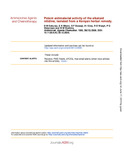| dc.contributor.author | GAKUNJU, DMN | |
| dc.contributor.author | MBERU, EK | |
| dc.contributor.author | DOSSAJI, SF | |
| dc.contributor.author | GRAY, AI | |
| dc.contributor.author | WAIGH, RD | |
| dc.contributor.author | WATERMAN, PG | |
| dc.contributor.author | WATKINS, WM | |
| dc.date.accessioned | 2013-06-17T13:01:28Z | |
| dc.date.issued | 1995 | |
| dc.identifier.citation | ANTIMICROBIAL AGENTS AND CHEMOTHERAPY, Dec. 1995, p. 2606–2609 | en |
| dc.identifier.uri | http://www.ncbi.nlm.nih.gov/pubmed/8592987 | |
| dc.identifier.uri | http://erepository.uonbi.ac.ke:8080/xmlui/handle/123456789/34981 | |
| dc.description.abstract | Bioassay-guided fractionation of extracts of Toddalia asiatica, a plant used by the Pokot tribe of Kenya to
treat fevers, has yielded the alkaloid nitidine as the major antimalarial component. Fractions containing
nitidine have in vitro 50% inhibitory concentrations against Plasmodium falciparum in the range of 9 to 108
ng/ml for a range of chloroquine-susceptible and -resistant strains. The results show a lack of cross-resistance
between chloroquine and nitidine. | en |
| dc.language.iso | en | en |
| dc.title | Potent Antimalarial Activity of the Alkaloid Nitidine, Isolated from a Kenyan Herbal Remedy | en |
| dc.type | Article | en |
| local.publisher | Ministry of Health, Kenya | en |
| local.publisher | The Wellcome Trust Research Laboratories | en |
| local.publisher | The National Museums of Kenya, | en |
| local.publisher | Kenya Medical Research Institute | en |
| local.publisher | Department of Pharmaceutical Sciences, University of Strathclyde | en |
| local.publisher | Department of Pharmacology and Therapeutics, University of Liverpool | en |

